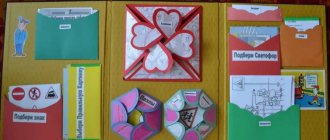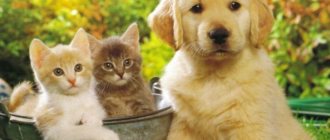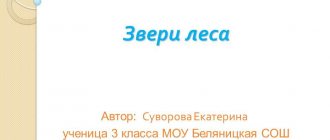Presentation for senior preschool age. (The world around us. Speech development) Pets.
#Educational and methodological materials #Presentation #Educator #Speech therapist #Preschool education
Pets Senior preschool age Goal: - Consolidate children's ideas about pets Tasks: Clarify and expand children's ideas about pets - appearance, who they live with, what benefits they bring, what they eat, how a person cares for animals; Clarify and expand the vocabulary on the topic: “Pets” (sneak, lap, meow, scratch, purr, lick, transport (people and cargo), graze, give (milk and meat), run, walk); Develop word formation skills; Continue to develop logical thinking, attention, memory, auditory and visual perception.
The dog eats meat and loves to chew bones. The dog lives in a kennel. Her cub is called a pup(s). A dog guards a person's home. The dog eats meat and loves to chew bones. The dog lives in a kennel. Her cub is called a pup(s). A dog guards a person's home. What can a dog do? Biting, running, walking, sitting, sleeping, eating, moving ears, wagging tail. The dog barks.
The cat eats mice and dairy products. The cat lives in a house near people. Her cub is called a kitten(s). A cat catches mice - this is how it helps a person. What can a cat do? Catching mice, purring, lapping milk, sneaking up, running, sleeping. The cat meows.
In summer it feeds on grass, and in winter on hay. The cow lives in a barn. Her baby is called a calf (calf). The cow gives man milk and meat. The cow moos.
The horse eats grass, hay, oats. The horse lives in a stable. Her young are called a foal(s). The horse carries a load. The horse neighs.
The pig eats vegetables, apples, grass. The pig lives in a pigsty. Her baby is called a piglet (piglets). A pig gives meat to a man. The pig grunts.
The rabbit eats carrots and cabbage. Lives in a cage. Its baby is called a baby rabbit. The rabbit gives meat.
The sheep eats grass and hay. A sheep lives in a sheepfold. Her baby is called a lamb(s). A sheep gives a person wool (yarn is made from wool, warm clothes are knitted from yarn. A sheep bleats.
The goat eats grass and cabbage. The goat lives in a barn, in a stable. Her baby is called a kid (goat). A goat gives a person milk and wool. The goat bleats.
Why are these animals called pets? (because they live next to a person, and the person takes care of them) Why are these animals called pets? (because they live next to a person, and the person takes care of them) Emerald eyes, Downy fur coat, Dear songs, Iron claws. (Cat.) What do we know about him? Guards the master's house, Now growls, now barks, Now wags its tail. (Dog) In front - a snout, in the back - a hook, in the middle - a back, on the back - a bristle. (Pig) I’ll help you guess who is grazing in the meadow. To keep us healthy, They give us milk... (Cows) Curls on the horns, And rings on the sides. He went out to eat some daisies. What's his name? (Lamb) With a beard, not an old man, With horns, not a bull, Milked, not a cow, Pulls its bast, But does not weave bast shoes. (Goat) He likes to eat carrots and cabbage for dexterity, And he watches Tolik’s cage, A fluffy one lives there... (Rabbit) A champion in fast running, I sometimes drive carts. Uncle groom brought me water, hay and oats. (Horse) Riddles
“The fourth odd one” “The fourth odd one” The game develops attention, thinking, logic, intelligence and speech. We need to explain WHY the animal is superfluous!!! Fox is a wild animal Chicken is a bird, not an animal
Foal - young, other adults Rabbit - no hooves.
Presentation for the project “Pets” for the junior-middle group
Irina Kravchenko
Presentation for the project “Pets” for the junior-middle group
Project type : informational and practical, short-term (5 days)
.
Target audience: children 3-5 years old.
Project participants : children, teachers, parents.
Relevance of the project : the animal is extremely diverse and attractive to children. Even in very early childhood, many of the children have the necessary opportunity to contact pets - cats , dogs, birds, etc. Animals become as integral a part of childhood as their favorite toys. Various situations of communication with pets provide a large stock of ideas about their characteristics and habits, awaken interest and curiosity, and develop skills in interacting with them.
Analysis of the problem: children are mostly familiar (have in their families)
with such representatives
of domestic animals as cats , dogs, parrots. What other pets ? To solve this problem, the project “World
of Pets ” .
Project goals :
Formation, expansion and generalization of children's knowledge about domestic animals .
Formation of an interested, caring attitude towards pets .
Developing children's interest in the world around them.
Project objectives :
Foster a humane attitude towards animals .
Clarify children's ideas about pets , their appearance, what voices they cast, where they live, what they eat, what benefits they bring?
Development of speech, thinking, imagination, curiosity, enrichment of children's vocabulary.
Encourage children to turn to adults with questions, judgments, and verbal communication with each other.
Improving children's drawing and creative skills.
Creating a visual image in children, eliciting an emotional response.
Expected result: enriching children's knowledge about the animal world of their immediate environment; familiarization with the rules of caring for pets .
Integration of educational areas
Cognition.
— View the presentation “ Pets ”
.
— Animals living in the countryside and in the city.
— Conversation-discussion “Putting problematic issues”
(see the progress
of the project ) .
— Conversation “What are the animals ?”
.
— Didactic games: “Recognize animals by description ”
,
"Who lives where?"
,
“Who brings what benefit?”
,
“Whose kids are these?”
,
“Who am I and how do I shout?”
.
— Watching the dog for a walk.
— Table lotto game on the theme “ Pets ”
.
— Working with the “House in the Village”
.
Communication
— — Games aimed at developing communication skills: “Guess who it is?”
,
“Whose traces?”
.
— Role-playing games: “Veterinary hospital”
,
"Dr. Aibolit"
.
— Conversation “How animals adapt to their environment? Human Behavior with Animals ."
— Review of the album “ Pets ”
and children’s composition of a descriptive story based on an illustration based on a diagram.
Socialization
— Game-task “Draw an animal and write a story about it”
.
— Didactic game “Help animals find their home ”
.
— Introducing children to communicate with each other in joint activities.
Reading fiction
— Review of books about animals .
— Reading poems by V. A. Stepanov “ Animal World of Russia ”
.
— Reading the Russian folk tale “The cat has a gray forehead, a goat and a ram”
.
— Reading K. Ushinsky Animal Dispute ”
, M. Prishvin
“Zhulka”
.
— Exhibition of books “ Animals in Fairy Tales ”
.
— Making riddles about pets .
— Reading proverbs and sayings about animals .
Artistic creativity
— Application: “Cats and dogs are our friends”
, design of a corner
of the group “Our Faithful Friends”
.
— Game-task “Draw an animal and write a story about it”
.
— Joint work of children and teachers - production of a joint exhibition “ Pets ”
.
Music
— Musical game “Guess the animal ”
.
— Learning the song “Tsap-scratch”
, music S. Gavrilova, lyrics. R. Aldonina.
Work
— A conversation about caring for pets (how to clean the cage, feed, the need for care, regardless of your mood).
— Duty in the book corner and nature corner.
Health
— Conversation “What leads to the death of animals and illness of people”
,
" Animal "
.
— Comparison of man and animal “How are we similar and how are we different?”
Game
“Beasts and People” (with a ball)
.
— Conversations about washing.
— Invigorating gymnastics after sleep (a set of breathing exercises)
.
Safety
— Conversation “Meeting with unfamiliar animals ”
, “Take care of the safety of your body after helping
animals .”
Physical Culture
— Exercise “Not guys, but animals”
(exercises:
“The cow drives away the midges”
,
“A horned goat is coming”
,
“
Domestic cat ” ,
“The horse kicks with its hoof”
,
“The bunnies are galloping”
).
— Physical exercises: “Cow”
,
"Cat"
,
"Kitty"
.
— Finger gymnastics: “Goat”
,
"Let's feed the animals "
.
— Articulation gymnastics: “Angry cat”
,
“Duck beak”
,
“Horse”
.
— Outdoor games: “Rabbits”
,
"The Mother Hen and the Chicks"
,
"The Shaggy Dog"
.
Forms of interaction with family and social partners:
Conversations with parents on the topic “Is there an animal ?”
.
Library for parents: books about nature, animals , articles about teaching kindness in children.
— Folder “Children and Pets ”
.


